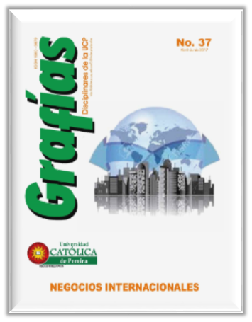Market structure in monopolistic competition and determination of the Balancing point - case 3. Company feels very nice
DOI:
https://doi.org/10.31908/grafias.v0i37.1214Keywords:
Equilibrium balance point, company, PYMES, microeconomics, accountan Keywords: structure of market, monopolistic competition, variable costs, equilibrium pointAbstract
This article is the product of collective performed in the first half of 2016 whose purpose is to know how the company Feels Very Nice has surpassed its equilibrium balance point, taking the market needs with high profitability. This has been characterized by having a positive impact on children’s footwear niche because it has positioned its brand with a current market their products nationwide and even with a projection to the international market.
References
Aktouf, O. (2001). La metodología de lasciencias sociales y el enfoque cualitativo enlas organizaciones. Cali: Universidad delvalle.
Banrep (Banco de la República) (2015).Sitio web. Disponible en http://www.banrepcultural.org/
Bolívar, J. (2009). Módulo costos ypresupuestos aplicados al diseño y a laevualacion del proyecto. Bogota: UNAD.Disponible en http://datateca.unad.edu.c o / c o n t e n i d o s / 2 1 0 1 0 9 / M O D U L O _C O S T O S _ Y _ P R E S U P U E S T O S _APLICADOS_AL_DISENO_Y_A_LA_EVALUACION_DE_PROYECTOS.pdf
Briones, G. (2002). Metodología de la investigacioncuantitativa en las ciencias sociales.ARFO, 24-45.
Carrasco, R. (2010). Contabilidad Financiera.Teoría y ejercicios prácticos. Valencia:Tirant lo Blanch.
Fair, K. (1992[1989]). Fundamentos deEconomía (2ª ed.). Naucalpan de Juarez,edo., México: Prentice Hall.
García, S. (2009). Administración FinancieraFundamentos y Aplicaciones. Cali:Prensa Moderna Impresores S.A.
Gómez, O. (2005). Naturaleza y Conceptosbasicos de costos. En: O. Gómez,Contabilidad de costos (pp. 7-12). Bogotá:Mc Graw Hill.
Gutiérrez, P. (2012). Break-Even Method ofinvestment analysis. Farm and ranch series,2. Disponible en http://extension.colostate.edu/docs/pubs/farmmgt/03759.pd
Horngren, C., Datar, S. y Foster, G. (2007).Introducción a los terminos y objetivos delos costos. En: C. Horngren, S. Datar y G.Foster, Contabilidad de costos (pp. 26-32).México: Pearson.
Mankiw, G. (2012). La conducta de la empresay la organizacion de la industria. En:G. Mankiw, Principios de economia (pp.218-220, 238-240, 255-257, 48-57). España:Thomson.
Mochón , F. (2010). Principios de Economía(4ª ed.). Madrid: Mc Graw Hill.
Parkin, M. (2004). Economía. México: AddisonWesley.
Polimeni, R., Fabozzi, F. y Adelberg, A.(2006). Costeo del producto. En: R. Polimeni,F. Fabozzi y A. Adelberg, Contabilidad decostos (pp. 76-80). Mexico: Mc Graw Hill.
Programa de Transformación Productiva.(s.f.). ProgramadeTransformaciónProductiva.Disponible en https://www.ptp.com.co/contenido/contenido.aspx?catID=744&conID=908
Samuelson, P. y Nordhaus, W. (2006). Losfundamentos de la economía. En: P. Samuelsony W. Nordhaus, Economía (18ª ed.) (pp.4-10, 20-30). Mexico: Mc Graw Hill.
Samuelson, P. y Nordhaus, W. (2010). Microeconomíacon aplicaciones a Latinoamérica.México: Mc Graw Hill.
Sánchez, P. (2008). Contabilidad general (6ªed.). México: Mc Graw Hill.
Tamayo, M. (1999). Aprender a investigar.Bogotá: ICFES.
Zapata, P. (2011). Contabilidad general. Bogotá:Mc Graw Hill.


